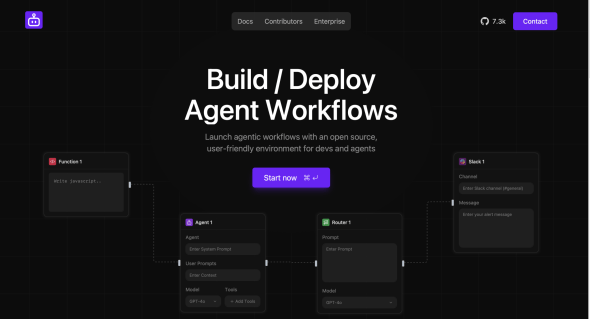Sim Studio – An Impressive Visual Tool for AI Workflows
Sim Studio is an open-source application designed for developers to construct, test, and run AI agents and their corresponding workflows. Introduced in 2024 by founders Emir Karabeg and Waleed Latif, and with support from Y Combinator, Sim Studio addresses a clear need in the market for specialized AI development tools. It is intended for developers, machine learning engineers, and technical teams who need to create capable autonomous agents without the delays of writing repetitive code.
Sim Studio central feature is its clear, Figma-like visual canvas that lets users connect components, switch between large language models (LLMs), and integrate with over 40 external tools using a drag-and-drop method. By offering a functional low-code environment, this platform changes the traditional code-intensive development process, accelerating the path from initial concept to a working product.
Best Use Cases of Sim Studio
- Developers and ML Engineers: A developer creating a complex AI agent can use Sim Studio to avoid writing boilerplate code for model and tool connections. For example, an agent can be built to monitor a GitHub repository, use a vector database to find relevant context from documentation, and then apply GPT-4o to propose a code fix. This entire logic can be mapped out visually on the canvas, which allows for fast iteration on any AI workflow.
- DevOps and Site Reliability Engineers (SREs): A DevOps professional can utilize Sim Studio to build an intelligent agent for responding to production alerts. Instead of only sending a notification, the agent can be set up to run diagnostic scripts automatically, check logs for specific error patterns, and then post a summary of the incident in a Slack channel with recommendations. This approach turns a reactive alert into a structured, automated response.
- Sales and Marketing Operations: A technical marketer responsible for lead qualification can build a dedicated AI workflow on the Sim Studio platform. A new lead from a website form can be automatically enriched with company information from an API, scored by an LLM against set criteria, and then immediately directed to the correct sales pipeline in a CRM. This creates a highly specific and effective lead management system.
- Technical Product Managers: A product manager can visually prototype new AI-driven features without consuming significant engineering time. They could design a workflow where an agent summarizes user feedback from support tickets, identifies recurring themes with an LLM, and then generates a detailed feature request in Jira. This allows for the quick testing of AI concepts before they enter the full development schedule.
Clear Visual Builder: The Figma-like canvas is well-executed, making the construction of a complex AI workflow feel straightforward and organized.
Open-Source Model: Being open-source gives users complete transparency, the ability to customize, and protection from vendor lock-in.
Faster Development Cycles: The tool greatly reduces development time by managing the underlying code for connecting LLMs, tools, and data sources.
Multi-LLM Compatibility: Users can switch between different LLM providers like OpenAI, Anthropic, or local models via Ollama without needing to redesign the workflow.
Built for Developers: Unlike simpler no-code tools, it offers the control and depth that developers require to build reliable, production-level agents.
Solid Integration Library: With over 40 pre-built connectors for popular tools like Slack, Pinecone, and Gmail, it is ready for many common applications.
No Cost to Start: The self-hosted version of Sim Studio is free, which makes it highly accessible for individuals, startups, and larger companies.
A New and Growing Platform: As a newer tool, it has less available documentation, a smaller number of tutorials, and a less developed community compared to more established platforms.
Technical Skill is Required: Although it is a low-code platform, it is not a "no-code" one. Users need a good grasp of development principles, APIs, and data flow to create complex agents.
Self-Hosting Demands: The free version requires you to host it yourself, which adds the complexity and cost of server management, updates, and security.
Fewer Connectors Than Market Leaders: While its 40+ integrations are a good starting point, it does not yet have the thousands of connectors available in platforms like Zapier or n8n.
- Visual Workflow Editor: A drag-and-drop interface for designing, linking, and setting up AI agent components.
-
Agent Node: The primary block for defining an agent’s instructions, including its system prompt, context, and choice of LLM.
-
Tool Nodes: Ready-to-use connectors for more than 40 third-party applications and services.
-
LLM Provider Support: Direct support for major LLM providers including OpenAI, Anthropic, and Google, as well as local models through Ollama.
-
API Deployment: Publish finished workflows as a secure API endpoint with a single action.
-
Chat Interface Deployment: Instantly deploy any workflow as an interactive chat widget for websites or apps.
-
Scheduled Triggers: Set up workflows to execute automatically on a schedule, similar to cron jobs.
-
Visual Debugging: An interface that lets you watch the execution path of your agent in real-time to simplify troubleshooting.
-
Knowledge Base Integration: Link your agent to data stores like vector databases to give it persistent memory and external context.
-
Local Development: The platform fully supports running and testing workflows on a local machine for privacy and cost control.
 Homepage Sim Studio
Homepage Sim Studio
 Sim Studio Workflow
Sim Studio Workflow
Frequently Asked Questions
-
What is Sim Studio?
Sim Studio is an open-source software application that gives developers a visual workspace to build, test, and operate AI agents and their automated workflows. -
Is Sim Studio free?
Yes, the application is open-source and free to use when hosted on your own infrastructure. -
Who is the target user for Sim Studio?
The SIM AI tool is built mainly for developers, machine learning engineers, and other technical users who understand API concepts and workflow design. -
How is Sim Studio different from Zapier?
Sim Studio is a low-code platform for building intricate, multi-step AI agents, whereas Zapier is a no-code tool for creating simple, direct automations between different web apps. -
How is Sim Studio different from LangChain?
LangChain is a code-first framework requiring users to write Python or JavaScript. In contrast, Sim Studio is a visual-first platform that abstracts code into a drag-and-drop interface. -
What large language models does Sim Studio support?
It supports models from major providers like OpenAI (GPT series), Anthropic (Claude series), and Google (Gemini), along with open-source models via Ollama. -
Can I run Sim Studio locally?
Yes, Sim Studio is designed to fully support local development and execution, which is useful for prototyping and maintaining data privacy.
Tech Pilot’s Verdict on Sim Studio Agentic Workflow
Having worked with many tools that aim to simplify the process of building AI applications, I understand the common frustrations with managing code and configurations. My main goal when reviewing Sim Studio was to determine if its visual method could genuinely streamline the creation of a useful AI agent, or if it was merely a different look for the same old development challenges.
To test this, I built a “Tech News Summarizer” agent. The task was clear: the agent, when triggered, would pull recent articles from an RSS feed, use an LLM to summarize the top three, and post the result to a Slack channel. This is a standard AI workflow that can become surprisingly complex when coded manually due to API calls and data handling.
Using Sim Studio for this was a refreshingly direct experience. I placed a “Start” node on the canvas, connected it to an “RSS Feed” tool node, and then fed that output into an “Agent” node. For the agent’s prompt, I wrote: “Summarize these articles into a three-bullet-point list for a busy executive.” I chose GPT-4o as the model. The last step was to link the agent’s output to a “Slack” tool node. The entire construction took about 15 minutes. The visual layout made the logic easy to follow, a significant improvement over tracking function calls in a coding project.
However, there was a learning process. Figuring out the correct data format to pass between nodes required some experimentation. While the debugging features were helpful, a more detailed data inspector would be a good addition. This shows that while Sim Studio is a low-code tool, a developer’s approach is still very beneficial.
Top Alternatives to Sim Studio
To understand Sim Studio‘s value, it is useful to compare it to others in the market.
-
n8n.io is the most similar alternative to Sim Studio in its core idea. n8n is a mature, open-source automation tool with a vast library of integrations. It excels as a general-purpose platform. However, it isn’t purpose-built for AI agents, so setting up LLM prompts and agent logic can feel less integrated. If your main goal is broad automation with some AI capability, n8n is a strong candidate.
-
Zapier is the leader in no-code automation for non-technical users. It connects thousands of apps and is very easy to use for simple tasks. It is not, however, designed for building complex, stateful agents. Creating our news summarizer in Zapier would be difficult and costly. Zapier is the best tool for simple app connections; Sim Studio is for building intelligent workflows.
-
Langflow acts as a graphical user interface for the LangChain framework, making it a direct alternative. It also uses a node system. The key difference is in their design philosophy. Langflow feels like a visual layer on top of a code-based framework. Sim Studio feels like a complete, visual-first platform, offering a more polished experience for developers who need to build quickly.
Final Verdict
After a thorough evaluation, I have a positive view of Sim Studio. It successfully occupies the space between powerful code-first frameworks like LangChain and simple no-code tools like Zapier. It is clearly an application made by developers, with developers in mind.
If you are a non-technical user, Zapier is a better choice. If you are an AI researcher who requires deep customization, you will likely prefer the control of pure LangChain. However, for the large number of developers and technical teams that need to build and deploy AI agents effectively, Sim Studio is an excellent tool. It makes the process of building with AI feel more direct and creative.

